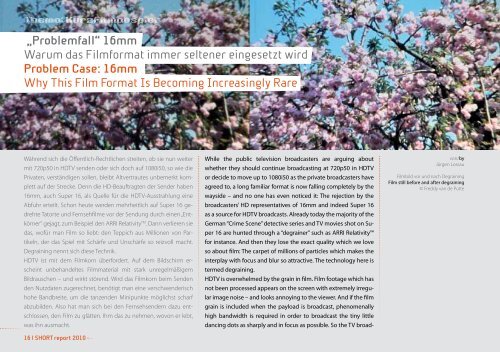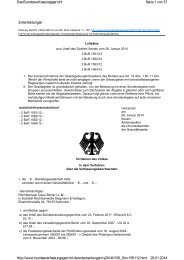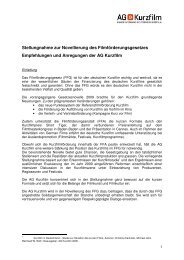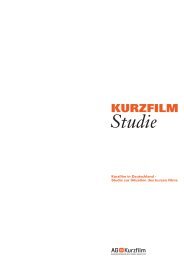short report - AG Kurzfilm
short report - AG Kurzfilm
short report - AG Kurzfilm
Sie wollen auch ein ePaper? Erhöhen Sie die Reichweite Ihrer Titel.
YUMPU macht aus Druck-PDFs automatisch weboptimierte ePaper, die Google liebt.
Thema: <strong>Kurzfilm</strong>abspiel<br />
„problemfall“ 16mm<br />
Warum das Filmformat immer seltener eingesetzt wird<br />
problem Case: 16mm<br />
Why This Film Format Is Becoming Increasingly Rare<br />
Während sich die Öffentlich-Rechtlichen streiten, ob sie nun weiter<br />
mit 720p50 in HDTV senden oder sich doch auf 1080i50, so wie die<br />
Privaten, verständigen sollen, bleibt Altvertrautes unbemerkt komplett<br />
auf der Strecke. Denn die HD-Beauftragten der Sender haben<br />
16mm, auch Super 16, als Quelle für die HDTV-Ausstrahlung eine<br />
Abfuhr erteilt. Schon heute werden mehrheitlich auf Super 16 gedrehte<br />
Tatorte und Fernsehfilme vor der Sendung durch einen „Entkörner“<br />
gejagt, zum Beispiel den ARRI RelativityTM . Dann verlieren sie<br />
das, wofür man Film so liebt: den Teppich aus Millionen von Partikeln,<br />
der das Spiel mit Schärfe und Unschärfe so reizvoll macht.<br />
Degraining nennt sich diese Technik.<br />
HDTV ist mit dem Filmkorn überfordert. Auf dem Bildschirm erscheint<br />
unbehandeltes Filmmaterial mit stark unregelmäßigem<br />
Bildrauschen – und wirkt störend. Wird das Filmkorn beim Senden<br />
den Nutzdaten zugerechnet, benötigt man eine verschwenderisch<br />
hohe Bandbreite, um die tanzenden Minipunkte möglichst scharf<br />
abzubilden. Also hat man sich bei den Fernsehsendern dazu entschlossen,<br />
den Film zu glätten. Ihm das zu nehmen, wovon er lebt,<br />
was ihn ausmacht.<br />
16 | ShOrT <strong>report</strong> 2010 e<br />
While the public television broadcasters are arguing about<br />
whether they should continue broadcasting at 720p50 in HDTV<br />
or decide to move up to 1080i50 as the private broadcasters have<br />
agreed to, a long familiar format is now falling completely by the<br />
wayside – and no one has even noticed it: The rejection by the<br />
broadcasters’ HD representatives of 16mm and indeed Super 16<br />
as a source for HDTV broadcasts. Already today the majority of the<br />
German “crime Scene” detective series and TV movies shot on Super<br />
16 are hunted through a “degrainer” such as ARRI Relativity<br />
for instance. And then they lose the exact quality which we love<br />
so about film: The carpet of millions of particles which makes the<br />
interplay with focus and blur so attractive. The technology here is<br />
termed degraining.<br />
HDTV is overwhelmed by the grain in film. Film footage which has<br />
not been processed appears on the screen with extremely irregular<br />
image noise – and looks annoying to the viewer. And if the film<br />
grain is included when the payload is broadcast, phenomenally<br />
high bandwidth is required in order to broadcast the tiny little<br />
dancing dots as sharply and in focus as possible. So the TV broad-<br />
von/by<br />
Jürgen Lossau<br />
Filmbild vor und nach Degraining<br />
Film still before and after degraining<br />
© Freddy van de Putte













